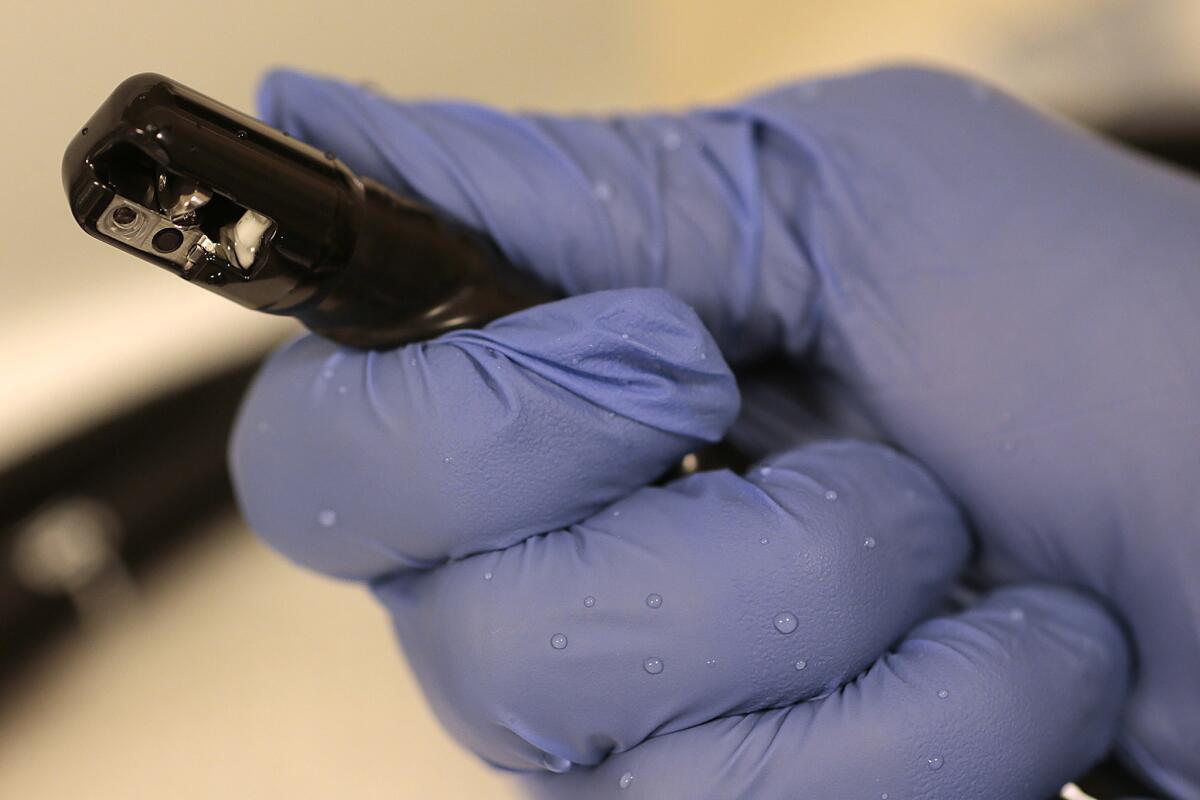Two more deaths may be linked to contaminated medical scopes

An Olympus duodenoscope is cleaned at Los Angeles County/USC Medical Center on Nov. 9, 2015.
- Share via
Two patients died and six more were sickened in a new outbreak suspected of being caused by contaminated medical scopes, according to a regulatory report by device manufacturer Olympus Corp.
The report shows that hospitals are continuing to use a device that was recalled in January, which experts have found to be extremely difficult to disinfect. The name and location of the hospital was not revealed in the report.
“It’s overwhelming,” said Glenn Smith, whose 19-year-old son nearly died after being sickened with a superbug from a scope at UCLA’s Ronald Reagan Medical Center in late 2014. “They’ve known about this for so long and people are still dying.”
In January, a U.S. Senate investigation said that the device known as the duodenoscope had been linked to at least 25 outbreaks worldwide. Three of the outbreaks happened at Los Angeles-area hospitals, including Cedars-Sinai and UCLA, where three patients died.
One day after the findings of the investigation were released, Olympus said it was recalling the reusable scope and replacing one of its internal mechanisms that could allow bacteria to remain trapped inside after cleaning.
The scope that the hospital used to treat the eight patients in the new report had not yet been sent back under Olympus’ recall.
Olympus said Friday that it had begun replacing the scopes known as model number TJF-Q180V in February. The company said it expects to have all 4,400 scopes in use by hospitals and clinics recalled by August.
Lawrence Muscarella, a medical safety expert in Montgomeryville, Pa., said hospitals should be warning patients before each scope procedure about the risk of an untreatable infection and whether the hospital is still using a device involved in the recall. He said he has not seen those warnings in forms that hospitals require patients to sign before a scope procedure.
Muscarella pointed out that the outbreak had been reported to the FDA by Olympus and not by the hospital.
Under federal law, hospitals must file a report to the FDA within 10 days of becoming aware that a medical device had caused a death.
The Senate investigation found that not one of the 16 or more American hospitals where patients were sickened appeared to have properly filed the required federal report.
Muscarella said the secrecy surrounding the outbreaks means that the public probably will never know how many patients died from infections tied to the scopes.
“The number of patients infected and killed … could be orders of magnitude higher,” he said.
In California, hospitals are required to report unusual events such as outbreaks to state health officials, but face no financial penalty if they don’t.
Deborah Kotz, an FDA spokeswoman, said the agency could not disclose the name of the hospital. Federal law prohibits such disclosure to protect the privacy of patients’ personal and medical files, she said.
“The FDA takes very seriously any deaths or serious injuries that are reported,” Kotz said. The agency is examining each report that has been filed, she said, and requesting additional information when necessary.
The duodenoscope is a long snakelike tube with a tiny camera on its tip. It is used nearly 700,000 times a year in the U.S. to treat cancer and other problems in the digestive tract. The procedure known as ERCP, or endoscopic retrograde cholangiopancreatography, can avoid surgeries.
Doctors also use the scope to diagnose conditions, a process that could be done in some cases with less invasive tests like an MRI.
Tokyo-based Olympus sells 85% of the duodenoscopes used by American hospitals. The other manufacturers are Pentax and Fujifilm. Their scopes have also been linked to outbreaks.
The FDA and Olympus have advised hospitals to take additional steps in cleaning the device to reduce the risk of infection. Yet hospitals are continuing to report that scopes remain contaminated after cleaning.
In the latest report, the hospital had been using an automatic washer sold by Olympus to clean its scopes. The washer was returned to Olympus for evaluation, according to the report.
Olympus said it was notified of the outbreak Jan. 26. The company said the hospital was doing an autopsy on the two patients who died to determine their cause of death.
Olympus said an independent lab found Stenotrophomonas maltophilia — a dangerous bacteria that resists many antibiotics — inside the scope’s suction channel.
The scope had been used almost 800 times by the hospital, the report said. It was purchased in June 2012 and last repaired by Olympus in August 2014.
Olympus technicians found cracks in the device and brown stains inside, the company said in the report.
Follow me on Twitter @MelodyPetersen
ALSO
Scope maker Olympus sought price hike amid superbug outbreak
FAA predicts that 4.3 million hobbyist drones will be sold by 2020
Business and N.C.’s anti-LGBT law: talk is cheap, but what are you actually doing about it?
More to Read
Inside the business of entertainment
The Wide Shot brings you news, analysis and insights on everything from streaming wars to production — and what it all means for the future.
You may occasionally receive promotional content from the Los Angeles Times.










